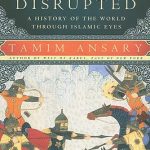A History of the World in 12 Maps by Jerry Brotton (Viking, November 2013) is not truly a world history story. It is, however, a look at how maps and history are intricately related. Each map throughout history tells what is important to the learned in the era in which it has been created. Likewise, each map contributes to how the subsequent generations continue to interpret the world.
I am fascinated by maps. Remember this classic episode from West Wing?
And then there are the people that some how can draw the whole world.
Or what about people able to map the world? (Even if it’s fake, it’s still pretty cool.)
My son also loves maps, especially when he has a destination he must reach by finding the best route. Google Earth is his game.
So, A History of the World in 12 Maps was very interesting and informational to me.
Here is a brief overview of the issues and maps Brotton addresses in his volume.
- Ptolmey’s Geography, which somehow is a map that all the others draw on. It was the first approach to mapping the known world, and he approached his map scientifically. (AD 150)
- Al-Idrisi, an Arabic mapper creating a map for a Sicilian king. It helped bring Europe and Asia together by exchanging ideas. (AD 1154)
- Hereford Mappamundi, which is an example of one of the many maps putting religion in the center of the world’s purpose. (AD 1300)
- Kangnido map, which mapped the empire of Korea/China in 1402.
- Waldseemuller’s world map, which labeled America for the first time. (1507)
- Ribeiro’s world map, which encompassed the things that Magellan’s crew had discovered on their journey around the world. (1529)
- Mercator’s world map, which gave a new perspective on the world with a new projection. (1569)
- Blaeu’s Atlas maior, which mapped the money-making East Indies for the Dutch. (1662)
- Cassini’s map of France, which was the first attempt at a truly accurate in-depth survey of the land. (1793)
- Mackinder’s sketch-like map “The Geographical Pivot of History,” which provided concepts to explore about how the geography of a place impacts it’s history and future (essentially, the beginning of geopolitics).. (1903)
- Peter’s projection, which attempts to provide a more accurate view of the earth, versus Mercator’s map. (1973)
- Google Earth, which is more a “geospatial” application versus a map, but takes user input into account to make it more democratic of a map than any others. (2012)
All of these maps have inaccuracies. All of them have bias.
I love reading history. My mind is expanded. True, history is always biased. I have always accepted that, but now I recognize how maps, too, cannot escape the bias of the era in which is has been created.
Brotton concludes with this:
There is simply no such thing as an accurate map of the world, and there never will be. The paradox is that we can never know the world without a map, nor definitively represent it with one.
I highly recommend A History of the World in 12 Maps to anyone interested in seeing how maps play a part in history and how history plays a part in the creation of maps.
Note: I received a digital review copy from the publisher last year for review consideration.





